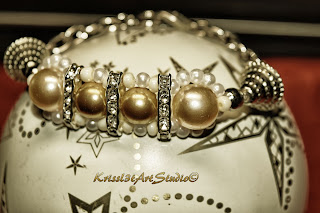On Autumn sale!
From £29.99- to £24.99 ;)
http://krissl3t.tictail.com/product/goddess-inannas-bracelet
Who is Inanna?
Inanna (Sumerian)
- Goddess of love, war, and fertility. Inanna was the personification of the
morning and evening star. Her beautiful name means "lady of the
sky." This Goddess is closely linked to Ishtar and Nin-anna.
Inanna (/ɪˈnænə/ or /ɪˈnɑːnə/; Cuneiform: 𒀭𒈹 (Old Babylonian) or 
 (Neo-Assyrian) DMUŠ3; Sumerian: Inanna; Akkadian: Ištar; Unicode: U+12239) was the Sumerian goddess of love, fertility, and warfare, and goddess of the E-Anna temple at the city of Uruk, her main centre.
(Neo-Assyrian) DMUŠ3; Sumerian: Inanna; Akkadian: Ištar; Unicode: U+12239) was the Sumerian goddess of love, fertility, and warfare, and goddess of the E-Anna temple at the city of Uruk, her main centre.
Inanna was the most prominent female deity in ancient Mesopotamia. As early as the Uruk period (ca. 4000–3100 BC), Inanna was associated with the city of Uruk. The famous Uruk Vase (found in a deposit of cult objects of the Uruk III period) depicts a row of naked men carrying various objects, bowls, vessels, and baskets of farm products, and bringing sheep and goats, to a female figure facing the ruler. This figure was ornately dressed for a divine marriage, and attended by a servant. The female figure holds the symbol of the two twisted reeds of the doorpost, signifying Inanna behind her, while the male figure holds a box and stack of bowls, the later cuneiform sign signifying En, or high priest of the temple. Especially in the Uruk period, the symbol of a ring-headed doorpost is associated with Inanna.
Seal impressions from the Jemdet Nasr period (ca. 3100–2900 BC) show a fixed sequence of city symbols including those of Ur,Larsa, Zabalam, Urum, Arina, and probably Kesh. It is likely that this list reflects the report of contributions to Inanna at Uruk from cities supporting her cult. A large number of similar sealings were found from the slightly later Early Dynastic I phase at Ur, in a slightly different order, combined with the rosette symbol of Inanna, that were definitely used for this purpose. They had been used to lock storerooms to preserve materials set aside for her cult. Inanna's primary temple of worship was the Eanna, located in Uruk (c.f. Worship).
The mythos of Inanna's assumption of the "me" from Enki, has been interpreted as a late insertion of the Goddess into the Sumerian pantheon, possibly associated with the archaeologically confirmed eclipse in the importance of Eridu and the rise of the importance of Uruk, at the end of the Ubaid period. Her temple, the Eanna would also seem to have been taken from Anu, the head of the Sumerian pantheon, prior to the rise of Enlil of Nippur. Inanna's name, which has no Sumerian etymology, has been linked with that of Hurrian Hannahannah, which supports this thesis of a later arrival, associated with the arrival of Proto-Euphratean farmers in Southern Iraq (see below, Etymology).
More information about this Goddess:



















































